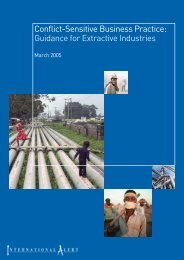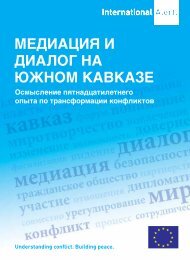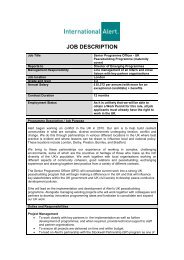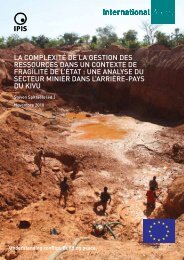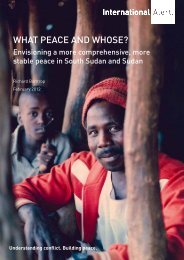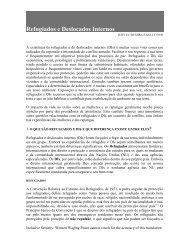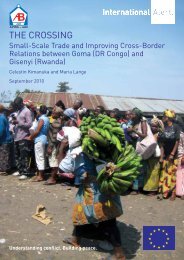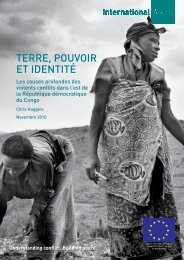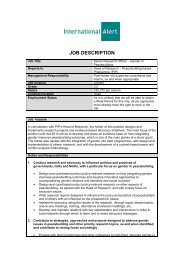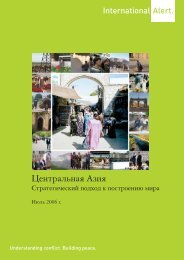The complexiTy of resource governance in a conTexT of sTaTe ... - Ipis
The complexiTy of resource governance in a conTexT of sTaTe ... - Ipis
The complexiTy of resource governance in a conTexT of sTaTe ... - Ipis
You also want an ePaper? Increase the reach of your titles
YUMPU automatically turns print PDFs into web optimized ePapers that Google loves.
<strong>The</strong> complexity <strong>of</strong> <strong>resource</strong> <strong>governance</strong> <strong>in</strong> a context <strong>of</strong> state fragility: An analysis <strong>of</strong> the m<strong>in</strong><strong>in</strong>g sector <strong>in</strong> the Kivu h<strong>in</strong>terlands<br />
15<br />
grown <strong>in</strong>to a town <strong>of</strong> over 20,000 <strong>in</strong>habitants, <strong>in</strong>clud<strong>in</strong>g several thousand m<strong>in</strong>ers, <strong>in</strong> less than a year. 10<br />
Although no longer as popular as <strong>in</strong> 2008, an estimated 3,000 artisans still dig for coltan at Kisengo,<br />
which has also become an <strong>in</strong>formal market for surround<strong>in</strong>g m<strong>in</strong>eral sites. 11 Kisengo is situated <strong>in</strong> a<br />
hunt<strong>in</strong>g reserve, mak<strong>in</strong>g it theoretically illegal to award the area as a m<strong>in</strong><strong>in</strong>g concession. Nevertheless,<br />
it was added to the list <strong>of</strong> potential ZEA areas (Zones d’Exploitation Artisanale). 12<br />
<strong>The</strong> map shows several relatively important gold sites north <strong>of</strong> the Kalemie–Nyunzu axis. Unlike the<br />
recent <strong>in</strong>terest <strong>in</strong> coltan, there is an established tradition <strong>of</strong> gold m<strong>in</strong><strong>in</strong>g <strong>in</strong> the northern territories<br />
<strong>of</strong> Katanga and some sites have been exploited for years. A number <strong>of</strong> currently active sites, such as<br />
Mulunguyi, halfway between Kongolo and Nyunzu, date back to the Mobutu era. 13 Now, after a<br />
period <strong>of</strong> limited activity and with an estimated workforce <strong>of</strong> 500 m<strong>in</strong>ers, Mulunguyi is once aga<strong>in</strong><br />
becom<strong>in</strong>g a popular site for gold. Lunga, the biggest gold-m<strong>in</strong><strong>in</strong>g site <strong>in</strong> Nyunzu, is located further<br />
north. This area suffers from persistent predation by army units (see paragraph 1.4).<br />
Many gold sites are remote and difficult to access, but this does not impede m<strong>in</strong><strong>in</strong>g s<strong>in</strong>ce gold<br />
is easy to transport on foot or by motorbike. Mulunguyi, for <strong>in</strong>stance, can only be reached by a<br />
mounta<strong>in</strong>ous 30km motorbike trail. It is another 60km by bike or on foot from there to Lunga.<br />
New sites are discovered from time to time. Follow<strong>in</strong>g fluctuations <strong>in</strong> world prices or local<br />
“get-rich-quick” stories, artisans migrate from one site to another. 14 Most artisans at the newly<br />
discovered Kalima gold site come from Kisengo, 30km further west. More than 1,000 artisans<br />
have moved <strong>in</strong>to the site <strong>in</strong> the past few months, stimulated partly by favourable gold prices.<br />
<strong>The</strong> southern tip <strong>of</strong> Nyunzu territory is another important m<strong>in</strong><strong>in</strong>g area. Here, situated among<br />
other, smaller sites, are the coltan and cassiterite m<strong>in</strong>es <strong>of</strong> Luba and Malemba. Information on the<br />
area is scant s<strong>in</strong>ce the m<strong>in</strong><strong>in</strong>g police refused access to it dur<strong>in</strong>g this research.<br />
Kalemie<br />
M<strong>in</strong><strong>in</strong>g <strong>in</strong> Kalemie occurs ma<strong>in</strong>ly <strong>in</strong> three areas. In the east, border<strong>in</strong>g the territory <strong>of</strong> Nyunzu,<br />
an important coltan m<strong>in</strong>e, ‘100 Kilos’, is situated near the village <strong>of</strong> Mayi Baridi. 100 Kilos has<br />
only been productive s<strong>in</strong>ce 2007 and, at the time <strong>of</strong> writ<strong>in</strong>g, production was up to two tonnes<br />
per month. A number <strong>of</strong> smaller gold m<strong>in</strong>es are located further north, towards the border with<br />
South Kivu. It is the only m<strong>in</strong><strong>in</strong>g area <strong>in</strong> Katanga where rebels from the Forces Démocratiques de<br />
Libération du Rwanda (FDLR) have a presence and pr<strong>of</strong>it from the ongo<strong>in</strong>g activity.<br />
A number <strong>of</strong> smaller gold m<strong>in</strong>es <strong>of</strong> limited importance are located southeast <strong>of</strong> Kalemie. This is<br />
a secure area where neither the FARDC nor armed groups <strong>in</strong>terfere with operations. Many more<br />
m<strong>in</strong>ers work <strong>in</strong> the gold sites <strong>of</strong> the adjo<strong>in</strong><strong>in</strong>g territory <strong>of</strong> Moba, which is beyond the scope <strong>of</strong><br />
this report.<br />
Manono<br />
In Manono and Malemba Nkulu, the parastatal company Zaire-Eta<strong>in</strong> produced 1.5 million tonnes<br />
<strong>of</strong> t<strong>in</strong> between 1985 and 1995, 15 when production halted because <strong>of</strong> national unrest and lack <strong>of</strong><br />
<strong>in</strong>vestment. Dur<strong>in</strong>g the war, artisanal m<strong>in</strong>ers started work<strong>in</strong>g the former Zaire-Eta<strong>in</strong> reserves,<br />
produc<strong>in</strong>g an estimated 200,000 tonnes <strong>in</strong> 1996. No private partner currently seems <strong>in</strong>terested<br />
<strong>in</strong> <strong>in</strong>ject<strong>in</strong>g the US$65 million the government considers necessary to rehabilitate <strong>in</strong>dustrial<br />
production.<br />
10 S Spittaels and F. Hilgert, Mapp<strong>in</strong>g Interests <strong>in</strong> conflict areas: Katanga. Update September-November 2007, IPIS, January 2008, pp. 5-6.<br />
11 R. De Kon<strong>in</strong>g, Demilitariz<strong>in</strong>g m<strong>in</strong><strong>in</strong>g areas <strong>in</strong> the Democratic Republic <strong>of</strong> the Congo: <strong>The</strong> case <strong>of</strong> Northern Katanga prov<strong>in</strong>ce, SIPRI Insights on<br />
Peace and Security, No. 2010/1, January 2010, pp. 4-5.<br />
12 Information taken from data from the Congolese Cadastre M<strong>in</strong>ier, 27 July 2010. IPIS has published the data as an electronic and <strong>in</strong>teractive<br />
map. See http://www.ipisresearch.be/maps/CaMi/web/<strong>in</strong>dex.html.<br />
13 Interview, Adm<strong>in</strong>istration de Territoire and Division des M<strong>in</strong>es, Kongolo, June 2010.<br />
14 See below for the reported discovery <strong>of</strong> a large nugget <strong>of</strong> gold at Lunga.<br />
15 DRC M<strong>in</strong>istry <strong>of</strong> M<strong>in</strong>es, Guide <strong>of</strong> M<strong>in</strong><strong>in</strong>g Investor, June 2003, p.20.





